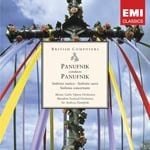Sinfonia Concertante (Symphony No.4)
(1973)fl-harp-strings(3.3.2.2.1 preferred)
Abbreviations (PDF)
Boosey & Hawkes
I composed this work as a token to my wife in the tenth year of our marriage. It is written for small orchestra in two movements: Molto cantabile and Molto ritmico (with the addition of a short passage which I called Postscriptum). The two movements have many directly contrasting characteristics: cantabile - ritmico; slow - fast; static – non-static; symmetry - asymmetry; flow - abruptness; lyrical elements - dance-like elements; etc. . . . The first movement could have been entitled Harmonia because of its almost perfect symmetry and its sense of concord. The second movement is made up of a cycle of asymmetric icrostructures, which are perhaps like the leaves of one tree, different in pattern, but of the same material growing from the same root. In fact the whole composition stems from one root only: a basic triad, with its horizontal reflections, together with a secondary triad with its vertical reflections brought in for contrapuntal and harmonic devices. Thus my Sinfonia Concertante is made up of these triads, very strictly preserved in every bar of the whole composition. For example, at the beginning, the flute plays the basic triads whereas the harp makes use of the secondary triads - both perpetually transposed of course. In the Postscriptum, the basic triad is reiterated several times consecutively by harp and flute (without reflections or transpositions) - a reaffirmation of the lyrical intent of the work.
Andrzej Panufnik
For musical examples and diagram illustrating the construction of this work, see the programme note section on www.panufnik.com
Reproduction Rights
This programme note can be reproduced free of charge in concert programmes with a credit to the composer

Sinfonia Concertante - Menhuin Festival Orchestra
Sinfonia Rustica / Sinfonia Sacra - Monte Carlo Opera Orchestra
Conductor: Panufnik
EMI Classics 3522892
